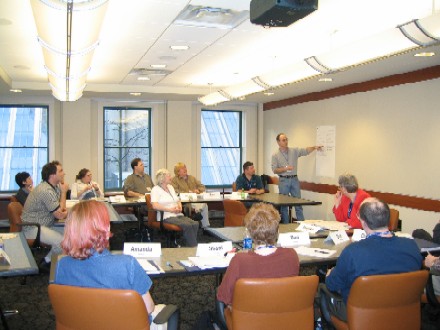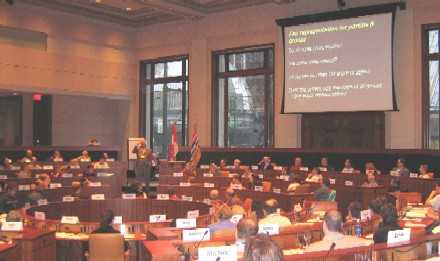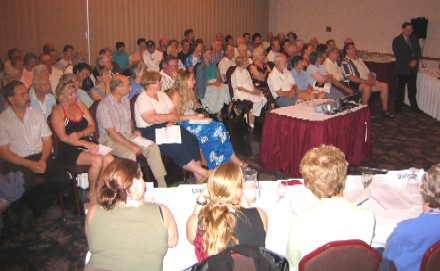The Citizens’ Assembly reports on Canada’s Pacific coast
Oct 29th, 2004 | By Randall White | Category: Canadian Provinces Democracy, according to much hyperbole in the air these days, is or ought to be the one thing we can all agree on. (As in the “Democracy Plaza” established by NBC at Rockefeller Center in New York, to help report on the perhaps somewhat historic US election of 2004.)
Democracy, according to much hyperbole in the air these days, is or ought to be the one thing we can all agree on. (As in the “Democracy Plaza” established by NBC at Rockefeller Center in New York, to help report on the perhaps somewhat historic US election of 2004.)
In Canada especially we have assorted good reasons to appreciate that, at the bottom of everything, real nation-building democracy still begins at home. And that’s one excellent reason to welcome the October 24 decision of British Columbia’s innovative Citizens’ Assembly, “recommending that B.C. adopt the Single Transferable Vote (STV) system” of proportional representation for its future provincial elections.
 More exactly, the Assembly has decreed that the people of British Columbia will decide on whether to adopt its particular chosen STV (aka “1, 2, 3”) model of electoral reform, at the next provincial election on May 17, 2005.
More exactly, the Assembly has decreed that the people of British Columbia will decide on whether to adopt its particular chosen STV (aka “1, 2, 3”) model of electoral reform, at the next provincial election on May 17, 2005.
All this can be quite confusing – at first, or even second or third blush. And who knows just where it will lead? For one thing, as the recent defeat of a proposal to adopt a ward system in Vancouver city politics suggests (to say nothing of the Charlottetown Accord, an even dozen years ago now), democracy on Canada’s Pacific Coast has some established tendency to finally turn down propositions put to the sovereign people in a referendum.
 In the very end, the most interesting aspect of the current BC electoral reform process may prove to be the more generic model of the Citizens’ Assembly itself. Whatever else you might want to say about Gordon Campbell’s provincial Liberals, they deserve some credit for pushing ahead with this rather intriguing contribution to the wider current debate on the so-called democratic deficit in Canada.
In the very end, the most interesting aspect of the current BC electoral reform process may prove to be the more generic model of the Citizens’ Assembly itself. Whatever else you might want to say about Gordon Campbell’s provincial Liberals, they deserve some credit for pushing ahead with this rather intriguing contribution to the wider current debate on the so-called democratic deficit in Canada.
Already, back east in Ottawa, both Stephen Harper of the new Conservatives and Jack Layton of the NDP have lately been calling for some similar innovative institution, to study a parallel version of electoral reform in Canadian federal politics. And the minority federal Liberals under Paul Martin have made ultimate assenting noises of some sort – during what might be called the 2004 throne speech consultation process, before and after the speech itself.
The Single Transferable Vote Proposal
 Especially with these federal overtones in mind, it is probably worth stretching our diverse Canadian minds a little on the BC Citizens’ Assembly’s particular Single Transferable Vote proposal for electoral reform. (And it is worth noting as well that Ontario, Quebec, and New Brunswick currently have somewhat parallel provincial reform processes in assorted earlier stages of development: See, e.g., the website of the non-profit and non-governmental advocacy organization, Fair Vote Canada.)
Especially with these federal overtones in mind, it is probably worth stretching our diverse Canadian minds a little on the BC Citizens’ Assembly’s particular Single Transferable Vote proposal for electoral reform. (And it is worth noting as well that Ontario, Quebec, and New Brunswick currently have somewhat parallel provincial reform processes in assorted earlier stages of development: See, e.g., the website of the non-profit and non-governmental advocacy organization, Fair Vote Canada.)
To start with, all such systems of “proportional representation” are meant to ensure that a political party receives about the same proportion of seats in the elected legislature that it wins in the wider popular vote. This has become attractive in Canada over the past few decades, because our current “First Past the Post” (FPP) electoral system has produced some dramatic discrepancies between shares of the popular vote and more decisive shares of legislative seats.

In BC itself, e.g. – as explained on the quite excellent Citizens’ Assembly website: “The 1996 election for the British Columbia provincial legislature resulted in the New Democratic Party, with 39% of the popular vote, winning more seats (39) in the Legislative Assembly than the Liberal party (33) that had won 42% of the popular vote. Thus, the NDP, with less popular support than the Liberal party formed the government for the next five years.”
This problem – which has had assorted parallels in other provinces and in Ottawa over the past few decades – flows from the arithmetic logic of Canada’s current electoral system. More exactly, under the country’s continuing traditions of British (or, as the more up-to-date euphemism has it, Westminster) parliamentary democracy, voters elect one member each for their local parliamentary ridings, based on whichever candidate wins the largest number of votes in the local election – or gets “First Past the Post.”
 Especially when more than two parties are contesting local ridings, this can indeed sometimes produce rather absurd discrepancies between the number of ridings a party wins and its share of the province- or country-wide popular vote – as our current increasingly diverse party systems in Canada have been showing us often enough in the more recent past. And it is of course the number of ridings or seats that finally counts in the parliamentary version of democracy.
Especially when more than two parties are contesting local ridings, this can indeed sometimes produce rather absurd discrepancies between the number of ridings a party wins and its share of the province- or country-wide popular vote – as our current increasingly diverse party systems in Canada have been showing us often enough in the more recent past. And it is of course the number of ridings or seats that finally counts in the parliamentary version of democracy.
The deeper waters of how to alter the arithmetic of this system, so as to bring the number of ridings or seats in parliament that a party wins into line with its wider democratic popular vote, raises technical issues than only actuaries and perhaps a handful of accountants even want to understand. In any short space it is enough to say that, among democratic places which have already adopted such “proportional representation” systems, two main models apparently prevail.

The first and perhaps somewhat more mainstream model, currently in use, e.g., in Germany and New Zealand, is known as “Mixed Member Proportional” (MMP). The BC Citizens’ Assembly, however, has recommended that British Columbia adopt the so-called “Single Transferrable Vote” (STV) model, currently in use in such other Westminister parliamentary democratic places as Ireland, Malta, Tasmania, and the Australian senate.
The explanation for this choice offered by Ken Carty, the UBC political science professor who has served as chief research officer for the BC Citizens’ Assembly, is that STV is a more “voter-focused” as opposed to “party-focused” system of proportional representation than MMP. And “assembly members … feel this system will make politicians more responsive to voters.”
 STV in any case does seem somewhat easier for we ordinary voters to understand. All we absolutely have to know is that multiple members will be elected for our riding, and all we have to do is rank the candidates on offer (1, 2, 3, etc), rather than put an “X” beside a single name, as at present. Some say that, from a voter’s standpoint, the system is “as easy as 1, 2, 3.”
STV in any case does seem somewhat easier for we ordinary voters to understand. All we absolutely have to know is that multiple members will be elected for our riding, and all we have to do is rank the candidates on offer (1, 2, 3, etc), rather than put an “X” beside a single name, as at present. Some say that, from a voter’s standpoint, the system is “as easy as 1, 2, 3.”
(And for those who insist on greater technical detail, Neal Hall has made a heroic effort to provide an as-succinct-as-possible explanation in the Vancouver Sun – complete with pages of arithmetic examples.)
The Citizens’ Assembly Model
 Perhaps the biggest knock on any model of proportional representation is that, especially in the kinds of rather fluid multi-party systems that have now evolved in Ottawa and many Canadian provinces, it will dramatically reduce the prospect of stable majority governments.
Perhaps the biggest knock on any model of proportional representation is that, especially in the kinds of rather fluid multi-party systems that have now evolved in Ottawa and many Canadian provinces, it will dramatically reduce the prospect of stable majority governments.
For the moment this may be somewhat less of an issue in British Columbia, which at least currently has only two major political parties – the Liberals on the right, and the NDP on the left. Yet even on Canada’s populist Pacific coast the “most-asked question” about the BC Citizens’ Assembly’s work, according to a late September 2004 piece by Sun columnist Vahghn Palmer, has been “Is this thing for real?”
 The same present First-Past-the-Post system that gave the BC Liberals short shrift in the 1996 provincial election, similarly turned around and gave them an overwhelming majority in 2001. With this most immediate history in view, it is only a little cynical to suspect that Gordon Campbell’s present BC government is not all that enthusiastic about actually implementing the Citizen Assembly’s proposed STV or any other proportional representation model.
The same present First-Past-the-Post system that gave the BC Liberals short shrift in the 1996 provincial election, similarly turned around and gave them an overwhelming majority in 2001. With this most immediate history in view, it is only a little cynical to suspect that Gordon Campbell’s present BC government is not all that enthusiastic about actually implementing the Citizen Assembly’s proposed STV or any other proportional representation model.
Under the legislation that the Campbell Liberals themselves passed to establish the Citizens’ Assembly, its recommendation must be voted on in a referendum to be held at the same time as the 2005 election (which already has a new fixed date, as also embraced in new Ontario provincial legislation).

But to win in 2005 STV will require the approval of 60% of the voters as a whole, and a simple majority of 50% + 1 in 60% of the present provincial ridings. (Or, as Vaughn Palmer has also recently noted, “the bar has been set high” here. It will not be easy for STV to finally win.)
However you look at it, as BC political analyst David Mitchell has recently explained, “STV represents a huge shake-up of the political process.” In the very end, even the voters in Canada’s most populist province may decide they do not need or want to be quite so bold.
 Yet regardless of just what may or may not happen to the particular cause of proportional representation in British Columbia next spring, already it seems clear enough that the more generic Citizens’ Assembly experiment – as a means of coming up with such tricky referendum questions – has proved an encouraging enough success.
Yet regardless of just what may or may not happen to the particular cause of proportional representation in British Columbia next spring, already it seems clear enough that the more generic Citizens’ Assembly experiment – as a means of coming up with such tricky referendum questions – has proved an encouraging enough success.
Again, the Assembly’s history, from the fall of 2002 down to the present, is nicely outlined, in some detail, on its own quite excellent website. Very briefly, proceeding from some innovative provincial legislation, a decision-making body of 160 ordinary citizens was chosen by lot, more or less on the model of jury selection.
 The Assembly has been managed by an executive and advised by research staff appointed by the provincial government. But the ultimate decision about what to recommend has been left entirely in the hands of its ordinary members. It met, studied, and deliberated on a number of occasions, and finally came up with a quite plausible recommendation on time.
The Assembly has been managed by an executive and advised by research staff appointed by the provincial government. But the ultimate decision about what to recommend has been left entirely in the hands of its ordinary members. It met, studied, and deliberated on a number of occasions, and finally came up with a quite plausible recommendation on time.
The underlying rationale for this scheme is that certain kinds of more fundamental processes of democratic reform are best kicked off by such ordinary citizen representatives of the sovereign people, rather than by professional politicians, who inevitably have so many other axes to grind. The BC Citizens’ Assembly experiment does seem to have shown that this kind of 21st century democratic thinking finally can be something more than pie in the sky.
 Whatever may happen to proportional representation in British Columbia (or any other province, or the country at large), it has already been suggested that this kind of innovation could equally be used, e.g., in dealing with such thorny Canadian constitutional issues as Senate reform. (Or, one might add, abolishing the remaining vestiges of the British monarchy, when we at last get around to bravely confronting this ultimate piece of the current democratic deficit in Canada.)
Whatever may happen to proportional representation in British Columbia (or any other province, or the country at large), it has already been suggested that this kind of innovation could equally be used, e.g., in dealing with such thorny Canadian constitutional issues as Senate reform. (Or, one might add, abolishing the remaining vestiges of the British monarchy, when we at last get around to bravely confronting this ultimate piece of the current democratic deficit in Canada.)
Or as David Mitchell has also said: “BC has always been a bit of a political pioneer in Canada and this assembly is another example … The province is going to continue to be an interesting political laboratory for some time to come.”
 And so the rest of us in Canada will no doubt be continuing to watch the laboratory with much interest, happy to live in a true northern country that includes such admirable democratic political pioneering somewhere, and especially perhaps in its most geographically fascinating province.
And so the rest of us in Canada will no doubt be continuing to watch the laboratory with much interest, happy to live in a true northern country that includes such admirable democratic political pioneering somewhere, and especially perhaps in its most geographically fascinating province.
(As soon, that is, as we can tear ourselves away from obsessively scrutinizing US television stations, for hints about who is going to win on November 2, in the original great North American republic, that sadly seems to have stumbled on a batch of troubled times. Which is all the more reason for doing what we can on Democracy Plaza North, somewhere in the depths of Vancouver Island.)
* * * * * *
The general website for the BC Citizens’ Assembly is at http://www.citizensassembly.bc.ca/public
counterweights would also like to thank the Assembly for a number of the photographs used above, some of which were taken by Assembly members.
